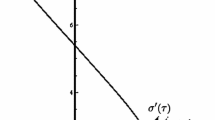Summary
The nonrelativistic classical and quantum equations of motion are exactly solved for a harmonic oscillator in the de Sitter and spatially flat Friedmann universes. In the latter case the creation of energy quanta owing to exchange of energy between the oscillator and the gravitational field is discussed and a comparison is made with the analogous relativistic phenomenon of particle creation in expanding space-times. By pursuing the Newtonian interpretation up to its ultimate consequences, it is found that, at the singularity, an infinite amount of creation of energy quanta occurs and that the Hilbert space structure of quantum mechanics becomes too narrow to accommodate the wave function which describes the state of the oscillator.
Riassunto
Le equazioni nonrelativistiche classiche e quantistiche del moto si risolvono esattamente per un oscillatore armonico nell’universo di de Sitter e nell’universo di Friedmann spaziale piatto. Nell’ultimo caso si discute la creazione di quanti di energia dovuti allo scambio di energia tra il campo oscillatorio e quello gravitazionale e si fa un confronto con l’analogo fenomeno relativistico della creazione di particelle negli spazi-tempi in espansione. Seguendo l’interpretazione newtoniana fino alle sue estreme conseguenze, si trova che, in corrispondenza della singolarità, avviene una creazione infinita di quanti di energia e che la struttura dello spazio di Hilbert della meccanica quantistica diviene troppo stretta per comprendere la funzione d’onda che descrive lo stato dell’oscillatore.
Резюме
Для гармонического осциллятора во вселенной де Ситтера и в пространственно плоской вселенной фридмана точно решаются нерелятивистскис классические и квантовые уравнения движения. В случае вселенной фридмана обсуждается образование энергетических квантов, связанное с обменом энергией между осциллятором и гравитапионным полем. Проводится сравнение с аналогичным релятивистским явлением образования частиц в расширяюшемся пространствевремени. Следуя ньютоновской интерпретации, получается, что в сингулярности образуется бесконечное количество энергетических квантов и структура гильбертова пространства квантовой механики становится слишком узкой, чтобы приспособить волновую функцию, которая описывает состояние осциллятора.
Similar content being viewed by others
References
G. C. McVittie:Mon. Not. R. Astron. Soc.,92, 868 (1932);E. Novotny:Commun. Math. Phys.,26, 321 (1972);J. K. Lawrence:Gen. Rel. Grav.,6, 253 (1975);P. Tourrenc andJ. L. Grossiord:Nuovo Cimento B,32, 163 (1976).
G. Audretsch andG. Schäffer:Gen. Rel. Grav.,9, 243, 489, (1978), and references therein.
L. Parker:Phys. Rev. D,22, 1922 (1980);L. Parker andL. O. Pimentel:Phys. Rev. D,25, 3180 (1982).
The yibrations of a diatomic molecule are crudely described by a harmonic-oscillator model, but this is a poor approximation and, in addition, the vibrational and rotational energy levels get mixed. See, for example,H. Eyring, J. Walter andG. E. Kimball:Quantum Chemistry (Wiley, New York, N. Y., 1944). Sect. 14e.
B. K. Berger:Phys. Rev. D,12, 368 (1975).
N. D. Birrell andP. C. W. Davies:Quantum Fields in Curred Space (Cambridge University Press, London, 1982), and references therein.
K. Kuchař:J. Math. Phys. (N.Y.),24, 2122 (1983).
H. C. Ohanian:Gravitation and Spacetime (W. W. Norton, New York, N. Y., 1976), p. 405.
D. W. Sciama:Modern Cosmology (Cambridge University Press, London, 1975), p. 115.
F. B. Hildebrand:Advanced Calculus for Applications (Prentice-Hall, Englewood Cliffs, N. J., 1962), Sect. 4.10.
D. C. Khandekhar andS. V. Lawande:J. Math. Phys. (N. Y.),16, 384 (1975).
G. N. Watson:A Treatise on the Theory of Bessel Functions (Cambridge University Press, London, 1966), p. 76.
A. Erdélyi, Editor:Bateman Manuscript Project, Higher Transcendental Functions Vol.2 (McGraw-Hill, New York, N. Y., 1953), p. 195.
A. Erdélyi, Editor:Bateman Manuscript Project, Higher Transcendental Functions, Vol.2 (McGraw-Hill, New York, N. Y., 1953), p. 85.
D. W. Sciama:Modern Cosmology (Cambridge University Press, London, 1975), Chapt. 8;S. Weinberg:Gravitation and Cosmology (Wiley, New York, N. Y., 1972), p. 474 and references therein.
See, for example,C. Cohen-Tannoudji, B. Diu andF. Laloë:Quantum Mechanics, Vol.1 (Wiley, New York, N. Y., 1977), p. 503.
E. Prugovečki:Quantum Mechanics in Hilbert Space (Academic Press, New York, N. Y., 1981), 2nd edition, theorem 4.6, p. 37.
Author information
Authors and Affiliations
Additional information
Partially supported by Conselho Nacional de Desenvolvimento Cientifico e Tecnológico, CNPq, Brasil.
Traduzione a cura della Redazione.
Переведено редакцией.
Rights and permissions
About this article
Cite this article
Lemos, N.A., Natividade, C.P. Harmonic oscillator in expanding universes. Nuovo Cim B 99, 211–225 (1987). https://doi.org/10.1007/BF02726583
Received:
Published:
Issue Date:
DOI: https://doi.org/10.1007/BF02726583




